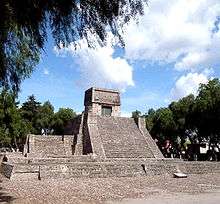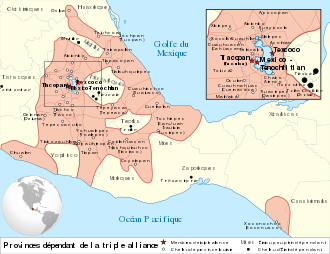Aztec architecture
Aztec architecture is a late form of Mesoamerican architecture developed by the Aztec civilization. Much of what is known about it comes from the structures that are still standing. These structures have survived for several centuries because of the strong materials used and the skill of the builders.[1]


Aztec cities often competed to construct the greatest temples in the Aztec empire. In so doing, instead of demolishing an old temple and building a new one at the same site, they simply built over the old structure. Some temples have been found to have at least four or five layers. Houses were uniform throughout most of the empire, only varying in size and ornamentation. Houses were built with logs and were not separated, thus resulting in one large room.
Aztec architectural sites include, Malinalco, Tenayuca (conquered by the Aztec circa 1434; the earliest known example of the typical Aztec double pyramid, which consists of joined pyramidal bases supporting two temples), and the Templo Mayor, the biggest building in the Aztec city Tenochtitlan.
Architectural styles
The Aztec civilization originated in Central America. Likewise, the architecture of the ancient Aztec architecture reflects that of the natives' traditions, culture, religion, and everyday life. The ancient Aztecs relied on cosmology, astronomy, and religion as their main sources of inspiration. The most prominent of features are the Aztec temples which were built for the purpose of appeasing the gods, so many of their features reflect that goal. The temples were terraced pyramids with steep stairs leading up to the main temple.
Symbolism
Eagle – representative of the sun and warriors
Serpents – represented water or fire
Conch shell – an important symbol of fertility
Frogs and sea creatures – represented Tlaloc Symbols [2]
Structural and engineering technologies
As seen in prior sections, the Aztecs had advanced knowledge of building techniques. J. A. Joyce, a journalist for The Burlington Magazine for Connoisseurs, states that "The physical geography of Central America was favorable to the rise of the art of building in stone" (159). Aztecs, with only primitive technologies, were very skilled with stone and masonry to construct these massive temples. With that, the Aztecs also had knowledge of brick and mortar. With this very strong combination, they built the massive structures that have withstood the test of time.
At the same time, with the high level of stone masonry, the Aztecs also knew how to properly build on the local geology and terrain. The area that this civilization is located in has a warm climate. The soil is soft and is prone to subsidence. The Aztecs realized this and built strong stone bases for the temples, similar to how a building or house has a foundation layer in modern time. These foundations made sure that the large structures on top of them would not crumble back into the earth.
The temples were not the only major works of engineering the Aztecs constructed. On top of the importance of the temples and their symbolism, the Aztecs also had a bustling civilization to take care of. They had advanced knowledge of agriculture and city planning. The ancient Aztecs used gravity to make a running water system, bringing fresh water to the city grid. They also employed terracing to enhance agricultural productivity.
Relationship with Aztec culture
From the artworks, temples, cultural contributions, and even the common household, the architectural style of the Aztecs always represented a higher power. This had aspects of human sacrifice. With that, the Aztecs designed their buildings to be functional for everyday life, as well as their religious practices.
The temples were designed as an ascending experience. There were multiple torn levels, all different in classes. At the top was the main temple. The idea of ascension was to prepare oneself so that the gods would be pleased when arriving at the top. At the top was where the sacrifices took place, so the Aztecs could be as close to the gods as possible to please them.
As for the households, they were simpler yet uniform to the rest of the civilization. The Aztecs did not want a mismatched civilization. This could displease the gods in the eyes of the Aztecs. Houses could be one to two stories tall and were for all classes. Priests were the only ones with access to the temples.
Tradition
As is already known, the Aztecs had rich traditions. They expressed it not only through their architecture, but their art as well. Sculptures and depictions of traditions, gods, local creatures, and much more decorated the streets and building sides. Much of this artwork is local to northern and central Mexico. The influence of this art can be seen as far as Utah in the United States. This shows the influence of the Aztecs at the time. These artworks are primarily preserved in museums at this point, but some still exist on site.
Separation of classes
One of the staples of all civilization is the separation of classes. As most civilizations do today, the Aztecs held this concept throughout their culture. As previously stated, the highest rank one could get in the Aztec social class was that of the priesthood. This gave access to the temples and richer quarters of the civilizations. These individuals lived around the temples while lower classes lived increasingly further away according to their status. The first circle was first class. The Second, middle class. The Third, lower class. Jan Marie Olson, a writer of Cambridge University Press, states that "this line of Aztec class analysis posits major differences in wealth, power and status leading to significant lifestyle differences between nobles and commoners" (133). The rich and the poor lived among each other, as religion brought the civilization together, but each class had different roles.
References
- Correspondence in Hobart, Okla N. "AZTEC ARCHITECTURE." The Construction News (1897-1916), vol. 21, no. 12, 1906, pp. 220, American Periodicals
- "Aztec Architecture". Legends & Chronicles. Retrieved 2019-09-24.
Umberger, Emily. “MATLATZINCO BEFORE THE AZTECS: JOSÉ GARCÃA PAYÓN AND THE SCULPTURAL CORPUS OF CALIXTLAHUACA.” Ancient Mesoamerica; Cambridge, vol. 28, no. 1, 2017, pp. 1–19
Restall, Matthew. “The Aztec Empire: a Surprise Ending?” The Historical Association, no. 134, 2017, pp. 12–17.
Olson, Jan M. “MATERIAL EXPRESSIONS OF WEALTH AND SOCIAL CLASS AT AZTEC-PERIOD SITES IN MORELOS, MEXICO.” Cambridge University Press, vol. 27, no. 1, 2016, pp. 133–147.
Joyce, J. A. “Some Features of Mexican Architecture.” The Burlington Magazine for Connoisseurs, vol. 19, ser. 99, June 1911, pp. 154–163. 99.
Further reading
- Bernal, I; Coe, M; et al. (1973). The Iconography of Middle American sculpture. New York: The Metropolitan Museum of Art.
- http://www.legendsandchronicles.com/ancient-civilizations/the-ancient-aztecs/aztec-architecture/
External links
| Wikimedia Commons has media related to Aztec architecture. |
